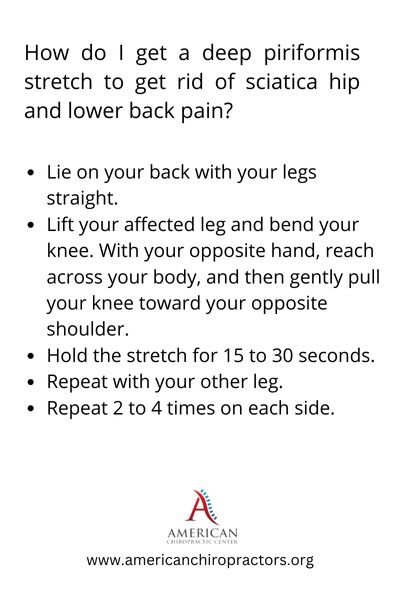Sciatica
10 Piriformis Stretches to Alleviate Sciatica, Hip, and Lower Back Pain

In our modern world, characterized by a sedentary lifestyle and constant hustle, many individuals experience chronic pain in the lower back, hips, or legs. Often, this discomfort can be attributed to the Piriformis muscle, which, when irritated, can lead to Piriformis syndrome and, consequently, sciatica pain.
Read more about 10 Piriformis Stretches to Alleviate Sciatica

This article introduces you to 10 effective Piriformis stretches that can alleviate sciatica, hip, and lower back pain.
More about 10 Piriformis Stretches to Alleviate Sciatica
Understanding the Anatomy
The Piriformis muscle lies deep within the buttock, near the hip joint. It is important for hip rotation and stability. However, its proximity to the sciatic nerve is crucial, as when the Piriformis muscle is tight or inflamed, it can put pressure on this nerve, resulting in pain that can radiate from the lower back to the legs. Besides Piriformis syndrome, other spinal conditions, such as herniated discs and spinal stenosis, can also cause sciatica pain.
The Importance of Stretching
Regular stretching can enhance flexibility, improve blood circulation, and alleviate muscle tension. When it comes to the Piriformis muscle, targeted stretching can reduce the tightness and relieve pressure on the sciatic nerve, making it an essential part of managing Piriformis syndrome and sciatica pain. Before beginning any stretch, ensure you are in a calm environment, and focus on your breathing.
10 Effective Piriformis Stretches
These stretches should be performed gently. If any movement causes pain, it’s a sign to ease up. Focus on stretching the Piriformis muscle and the surrounding hip muscles:
Basic Seated Stretch: Sit on a chair, cross the affected leg over the knee of the other leg, keep your spine straight, and gently bend forward. Hold for 30 seconds.
Standing Piriformis Stretch: Stand with your back against a wall, place the foot of your painful leg over the knee of the other leg, lower your hips at a 45-degree angle, and swing your arms down while keeping your back straight. Hold for 30-60 seconds.
Supine Piriformis Stretch: Lie on your back with legs bent upwards, cross the affected leg over the other leg, grab your knee with one hand and ankle with the other, and pull the leg toward your chest. Hold for 30 to 60 seconds.
Outer Hip Piriformis Stretch: Lie on your back, bend the affected leg, place your foot next to the back of the other knee, twist your leg to the opposite side so your knee touches the ground, and place your opposite hand on the knee. Hold for 20 seconds.
Groin and Long Adductor Stretch: Sit on the floor and spread your legs wide. Tilt forward at your hips and place your hands on the floor. Hold for 20-30 seconds.
Inner Thigh Stretch: Sit with your back straight and press the soles of your feet together. Push your knees down toward the ground. Hold for 30 seconds.
Side Lying Clam Exercise: Lie on your side with the hip that needs stretching on top. Bend your knees and position them forward. Keep your feet together and raise your upper knee without moving your pelvis. Hold for 10 seconds.
Hip Extension Exercise: Position yourself on the floor on your hands and knees. Lift one knee off the floor and push that leg out behind you. Return to the starting position and repeat 15 times on each side.
Supine Piriformis Side Stretch: Lie on your back, bend your knees upward, place your right ankle over your left knee, grip your thigh, and pull it towards you. Hold for 30 seconds and switch.
Long Adductor Stretch: Sit on the floor and open your legs as wide as possible. Tilt your upper body forward at the hip and place your hands on the floor. Lean forward and lower your elbows to the ground if possible. Hold for 20 seconds.
Additional Considerations
While these stretches can be highly effective, it’s also important to consider other aspects of your lifestyle that might contribute to Piriformis syndrome or sciatica pain. Maintaining a healthy weight, wearing proper footwear, and practicing good posture can also make a significant difference.
Unlock Freedom from Discomfort with these 10 Piriformis Stretches to Get Rid of Sciatica, Hip, and Lower Back Pain
Regularly performing these Piriformis stretches can greatly alleviate sciatica, hip, and lower back pain. Listen to your body, and remember to perform these stretches slowly and gently. If pain persists, it is advisable to consult a physician or physical therapist for personalized guidance. Stretch your way to a pain-free life!
FAQs on 10 Piriformis Stretches To Get Rid Of Sciatica, Hip, And Lower Back Pain
What is the significance of keeping the affected leg underneath during piriformis stretches?
Keeping the affected leg underneath helps isolate the piriformis muscle, which is one of the external rotators of the hip. This position helps in achieving a deeper stretch, relieving tension, and alleviating pain associated with piriformis syndrome.
Why is it important for the foot of the affected leg to be flat on the floor during stretches?
Keeping the foot flat on the floor ensures stability and proper alignment of the hip and lower extremities. It prevents undue stress on the knee and allows for a focused stretch on the piriformis muscle and other hip muscles.
How does pushing the chest forward contribute to piriformis stretching?
Pushing the chest forward during a piriformis stretch increases the stretch in the hip and lower back region. This posture elongates the spine and opens up the hip flexors, facilitating a deeper stretch and promoting relief from hip pain and irritation of the sciatic nerve.
How can I achieve a deeper stretch in piriformis exercises?
A deeper stretch can be achieved by maintaining a proper form, slowly leaning forward, and holding the stretch for 20-30 seconds. Gradually increase the intensity without causing pain, and ensure that the supporting foot is flat and that your chest is pushing forward.
Are there exercises that should be avoided when experiencing piriformis syndrome pain?
Yes, it’s best to avoid high-impact exercises and those that put a strain on the hip and lower back. Deep squats, leg raises, and heavy weightlifting should be approached with caution, as they can exacerbate the irritation of the sciatic nerve due to a tight piriformis muscle.
Why is glute stretch beneficial for piriformis syndrome?
A glute stretch helps in stretching not only the gluteus muscles but also the piriformis muscle, which is located in the buttock region. This helps relieve tension in the area, reducing pressure on the sciatic nerve and mitigating hip pain and lower back discomfort.
What are the benefits of hamstring stretches for piriformis syndrome?
Hamstring stretches can alleviate tension in the back of the thigh and relieve pressure on the pelvis and lower back. This indirectly benefits the piriformis muscle by creating a more conducive environment for it to relax and reduce irritation of the sciatic nerve.
Why is hip stretch important in relieving hip and lower back pain?
Hip stretches target the hip flexors and external rotators, including the piriformis muscle. Stretching these muscles can alleviate tension and tightness, improving the range of motion and decreasing pressure on the sciatic nerve, which often manifests as hip and lower back pain.
How do I perform the lying flat piriformis stretch with opposite hands touching the ground?
To perform this stretch, lie flat on your back with your legs straight. Cross your affected leg over the other, and use your opposite hand to gently pull the knee of your affected leg across your body until you feel a stretch in your buttock and hip. Keep both shoulders touching the ground. Hold for 20-30 seconds.
What’s the significance of keeping the opposite arm touching the ground while stretching the affected leg toward the opposite shoulder?
Keeping the opposite arm touching the ground helps maintain balance and proper alignment of the spine during the stretch. This ensures that the stretch effectively targets the piriformis muscle without causing strain on the lower back or spine.
How do I perform the short adductor (inner thigh) stretching exercise?
To perform the short adductor stretch, sit on the floor with your back straight, and put the soles of your feet together. Place your hands on your ankles or feet. Push your knees down with your elbows while leaning forward from your hips. Hold for 20-30 seconds, feeling the stretch in your inner thighs.
What should I keep in mind while sitting on the floor during piriformis stretches?
While sitting on the floor during piriformis stretches, make sure your back is straight, your shoulders are relaxed, and both feet are flat on the floor. Engage your core muscles and focus on isolating the piriformis muscle by gradually pushing your knees to the ground and leaning forward without straining.
What is the proper technique to slowly return to the original position after completing a piriformis stretch?
To slowly return to the original position, release the stretch gently and use your core muscles for support. Move in a controlled manner to prevent any sudden movements that might cause muscle strain or injury. Take deep breaths and maintain proper alignment throughout the transition.
How can I perform a buttocks stretch to relieve piriformis syndrome?
To perform a buttocks stretch, sit on the floor with both legs straight. Bend one knee and place the foot on the outside of the other thigh. Twist your torso toward the bent knee while keeping your pelvis straight. Hold the stretch for 20-30 seconds, and then switch legs.
What is Cauda Equina Syndrome and is it related to piriformis syndrome?
Cauda Equina Syndrome is a serious condition where the nerves at the end of the spinal cord are compressed. It causes severe lower back pain, loss of bladder control, and leg weakness. While not directly related, piriformis syndrome can mimic some of its symptoms due to sciatic nerve compression. If experiencing severe symptoms, it’s crucial to seek medical attention.
What exercises should be avoided when trying to treat piriformis syndrome?
Exercises that put excessive strain on the hips and lower back, such as heavy squats, leg presses, or high-impact activities, should be avoided when treating piriformis syndrome. Focus on gentle stretching and strengthening exercises that target the piriformis muscle without exacerbating the condition.
Why is it recommended to keep the knees bent during certain piriformis stretches?
Keeping the knees bent during piriformis stretches can help to isolate the piriformis muscle and reduce strain on the lower back. It allows for a more focused stretch and helps in relieving sciatic nerve pain associated with piriformis syndrome.
What is the significance of keeping the legs flat during supine piriformis stretches?
Keeping the legs flat during supine piriformis stretches ensures that the lower back is supported and the stretch is focused on the piriformis muscle. This position minimizes strain on the lower back and helps in effective sciatica pain relief.
How do I perform an outer hip stretch for piriformis syndrome?
To perform an outer hip stretch, sit on a chair with both feet flat on the floor. Cross your affected leg over the other at the knee, creating a figure 4. Gently press down on the knee of the crossed leg and lean forward slightly, keeping your back straight. Hold for 20-30 seconds and switch legs.
Why is it important to keep the pelvis straight during piriformis stretches?
Keeping the pelvis straight ensures proper alignment of the spine and hips, which is crucial for the effectiveness of the stretches. It helps in isolating the piriformis muscle and prevents additional strain on surrounding muscles and joints.
How can piriformis stretches help in relieving sciatic nerve pain?
Piriformis stretches can help relieve sciatic nerve pain by loosening the tight piriformis muscle, which might be compressing the sciatic nerve. The stretches improve flexibility, reduce muscle tension, and increase blood flow to the area, contributing to pain relief.
What are some tips for achieving sciatica pain relief through piriformis stretches?
For sciatica pain relief, perform piriformis stretches regularly, maintain proper form, and avoid over-stretching. Incorporate a variety of stretches to target different areas, keep the pelvis straight, and focus on gentle, controlled movements.
How do you perform the supine piriformis stretch lying down?
To perform the supine piriformis stretch, lie flat on your back with your legs straight. Bend one knee and place the opposite ankle on top of the thigh just above the knee. Hold the back of the thigh of the bent leg and gently pull towards your chest. Hold for 20-30 seconds, then switch legs.
Is it necessary to switch legs while performing piriformis stretches?
Yes, it’s important to switch legs to ensure both sides of the body are equally stretched and strengthened. Focusing only on the affected side can create muscle imbalances and might not efficiently treat piriformis syndrome.
How can consistent stretching routines help treat piriformis syndrome?
Consistent stretching routines can help treat piriformis syndrome by improving the flexibility of the piriformis muscle, reducing muscle tension, and increasing blood flow. This aids in alleviating pressure on the sciatic nerve and can contribute to long-term relief from symptoms.

Doctor Osvaldo Pepa, Neurosurgery Service Physician at Hospital San Martin, La Plata, Argentina. I graduated last November 16, 1984 with a Medical Degree at the Universidad Nacional de La Plata. The Medical Board of La Plata, District 1, licensed me as a Neurosurgeon in 1990. I hold a Provincial and National License and an active member of the Neurosurgery Society of La Plata, World Ozone Therapy Federation, and Inter American Society of Minimally Invasive Surgery.























